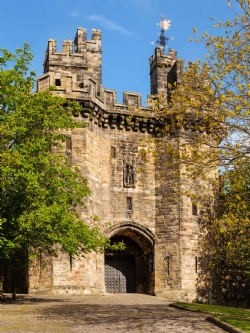
Lancaster Castle throws open its ancient gates
16th May 2013An exciting new era in the life of historic Lancaster Castle begins today when the imposing John O’Gaunt gates will be swung open to allow the public inside on a permanent basis. The gates will then be open every day from 10am to 5pm.
The gates will be officially opened by Gordon Johnson, the Constable of the Castle, a title established by King Henry IV in 1400.
With its 900-year history as an enclave of crime and punishment, Lancaster Castle???s interior has for centuries generally been considered a place for the incarceration of those on the wrong side of the law. But the formal closure of the HM Prison in March 2011 signalled a new dawn for the castle???s future role in Lancaster, whose skyline the castle dominates, and national life.
Once inside, visitors can get a glimpse of the castle???s magnificent interior from its large internal courtyard, as well as undertake tours of the historic buildings including the more modern prison. Visitors will also be able to call into the new cafe as well as popping in to a new gift shop.
The popular tours run by Lancashire County Council???s museums service at Lancaster Castle will, from May 25, start and finish at the cafe and will include the Castle Courtyard as well as parts of the former HM prison.
The remainder of the Bank Holiday weekend will see free events including military re-enactments, puppet workshops, circus performers, birds of prey demonstrations and much more in the castle courtyard.
History
Lancaster Castle occupies a city-centre hilltop location on the site of three successive Roman forts. It consists of an extensive group of historic structures, including the 12th Century Keep, the 14th Century Witches’ Tower, the 15the Century Gatehouse, and the Female Penitentiary, which dates from the early years of the 19th Century. It is a Grade I Listed Building, with the area to the north of it designated as a Scheduled Ancient Monument.
It is currently still used as a Crown Court and was a prison until March 2011. In the 16th Century it housed one of England???s most famous trials involving The Pendle Witches, which saw 10 people found guilty of “making a covenant with an evil spirit, using a corpse for magic, hurting life or limb, procuring love, or injuring cattle by means of charms”. They were sentenced to death and hanged on the moor above Lancaster.
English Heritage has described the Castle as being, “not only the North-West’s most important historic and archaeological monument but also of international importance”.
The Duchy of Lancaster
Though much of the castle will still remain inaccessible for the time being its owner, The Duchy of Lancaster, has already engaged the public in consultation about its future use and is keen to make more of the centuries-old buildings accessible.
The Duchy of Lancaster is custodian of over 18,000Ha of land and properties across England and Wales which are long-term capital assets kept in perpetuity for the reigning Monarch. HM The Queen is the Duke of Lancaster. And as such this is the Queen???s great undiscovered castle.


